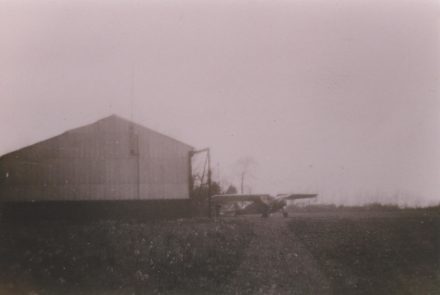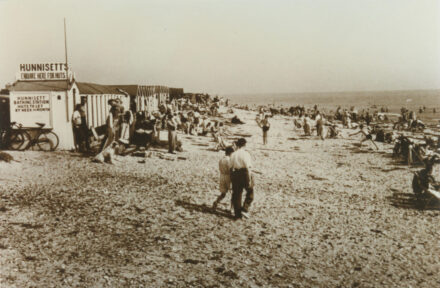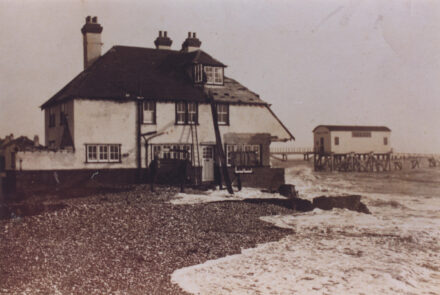PART 1
The Tower Mill we see today is not the one we started out with. Our original mill was Tidal and I am indebted to the Rev. John Cavis-Brown for this description included in his ‘Maps of Selsey in the County of Sussex in the years 1672 and 1901’ a copy of which may be found in the Reference Library in Selsey:
‘…the Water Mill…had flood-gates at each end. At high tide the western gate was closed and the other opened, so that the water flowed through the mill and out through the harbour to the sea on the east.’ He includes the Mill on his 1672 map.
Picture courtesy of The Mills Archives Trust – millsarchive.org

The Water Mill disappeared into the sea through coastal erosion and a windmill was built further inshore, well above the high water mark. It was well placed for the wind but was a timber structure and it took the full force of the elements. There is some suggestion that it was a Post Mill, the body of which was constructed to pivot on a central post. This is a picture of Fishbourne’s Post Mill so perhaps Selsey Mill was built on similar lines. Milling was done using pairs of stones.
But, actually, we can take the Mill back even further to 1641 when Thomas Wetheor was the Miller of Selsey. I was fortunate to find his will in the National Archives which was written on 30 December 1640 and proved on 3 July 1641. From this Will we know Thomas had a wife named Anne, who he has named as ‘whole and sole Executrix’, a son named William and a daughter named Marie.
This Will contains a rather wry comment inasmuch as Thomas left some lands in Bognor which his daughter and her heirs could have, once the lease ended, and that John Bridger ‘who now occupies it’, should stay on the property until he had ‘worn out’ the money I owe him’. A rather different slant on a ‘sitting tenant’.
There is also a Burial recorded of one Thomas Withier in the Parish of St Peter, Selsey with a date of 6 January 1641. Spelling was a lot more fluid in the 17th Century!
Next, we have a record dating from 1730 when John Reeves, Miller, married Mary Perrin(g). The difficulty with this chap is that he had a brother called William, a son called John and another son called William. John senior wrote his Will on 13 April 1744 and it is lodged in the West Sussex Record Office. He left everything to his wife Mary, with a bequest to son John who was to own the Mill and house with the proviso that he paid £50 to his brother, William, once he reached the age of 24. However, there was a catch. Mary could only have the bequest if she didn’t remarry. If she did, then her portion was to pass to John his brother William who would bring up the children as he saw fit and administer the estate for their benefit. By 3 March 1764 John senior had died.
At that time, John junior, who married Margaret, signed a conveyance and indenture over to his uncle William. This was to be the first of many such transactions related to what is, at this time, called Selsey Mill.
On 3 December 1782 a fire insurance schedule reads as follows:
‘Mr William Reeves of Selsea, in Sussex, Miller.
On his windmill with going gears situated as aforesaid, timber: £200
On his dwelling house only, distant, brick & tiled: £200’.
This rather scuttles the assertion from some sources that the current brick Tower Mill was built in 1750. The key word in the schedule is ‘timber’.
In 1783 William Reeves was Selsey’s Miller but he died in 1791 leaving a Will in which he bequeathed £200 and interest money from outstanding loans to his brother John. His mother, Mary, was granted an annuity of £20 free of all taxes but this was to be paid out of lands in East Wittering. There is a codicil to this Will dated 8 June 1791 so I think we can assume William died after that date!
Rev. James Dallaway, writing his County History of the Western Part of Sussex in 1815, made no mention of a Mill in Selsey. We are indebted to the Hampshire Telegraph of 2 June 1888 for their retrospective article which tells us of ‘the man who was lifted up by the arm of a windmill at Selsey, in 1803, and shaken out of recognition.’ Many such accidents were reported by the Press and not only at Medmerry Mill. It seems a Miller’s life, and that of his family, was fraught with danger.
By 24 March 1813 William, late of the Parish of Selsey, Miller had died and nephew John was the Selsey Miller.
The document concerned was an Indenture of 5/- (5 shillings) which was a lease for one year from John Guy and John Reeves to Charles Boniface.
The following day John Reeves received from Charles Boniface the sum of £800 and the above three gentlemen signed a Mortgage on the windmill and other premises. At the same time, John Reeves paid a Bond on the Mortgage to Charles Boniface who came from Bosham.
Although no documentary evidence has come to light, it is likely that we acquired our current Selsey Mill, erected by and at the charge of Thomas Colebrook perhaps ca. 1805. By 1820 a brick tower Windmill was built using local red bricks. The bricks were laid upon the header’s course principle. I am reliably informed that all the bricks are laid with the headers facing the outside which, of course, creates a solid wall, as thick as the brick is long, to support the heavy internal machinery. The Mill had ‘a white beehive cap around which was built a gallery. It was the only example of its kind in Sussex, and its purpose was to enable the miller easy access when furling or unfurling the four common, or canvas rigged sails.’ The mill had a weekly grinding capacity of some 10–12 loads of wheat.
Certainly, a lease for one year dated 29 July 1825 mentions the fact with the Mill being ‘as heretofore erected’. It also mentions that prior to that we had a Water Mill also known as Selsey Mill. The following day John Reeves and George Copis made a release and conveyance worth £300 to one George Goldring of West Dean and, on the same day, John Reeves and George Goldring signed a bond to Goldring with a penal sum of £700 and with 6 months in which to pay £350. Four wrought-iron salt pans were in place by 1827, each 9 ft. square. This fact is at odds with Wikipedia which states that our Mill was built ca. 1827.
An Indenture and Conveyance and Covenant were issued on 28 June 827. The Conveyance covered a Freehold Mill and premises and the Covenant to surrender a certain messuage, garden and premises. Signatories were John Reeves, Miller, George Goldring, George Copis, William Cobden Rhoades and Richard Lee. Goldring wanted to sell the windmill without asking John Reeves by public auction or private sale. John Reeves had to relinquish all his holdings to the Lord of the Manor and he surrendered on 31 August 1825. Whereas George Copis was originally associated with John Reeves, he seems to have ‘changed sides’. George Copis gave Richard Lee £1616.10s.9d and George Goldring £381.10s.0d plus £35. 6s.5d. John Reeves only received £16. 5s.10d from George Copis.
In 1828 the mill was seized to cover rent arrears and was sold by auction, lock, stock and barrel.
The first Miller listed on Wikipedia is Thomas Faith – his son, Owen, was born in Selsey in 1830 while his daughter, Sarah, followed along in 1833 and another son, Alfred, in 1836. Despite the fact that Rev. Thomas Walker Horsfield made no mention of a Mill when he wrote his History of Sussex in 1835/6, the 1841 Census has Thomas Faith at the Mill, implying that the Mill was still in operation. This is confirmed by Kelly’s Directory for 1841 when Thomas is listed as being there too. Thomas died in 1846. He was gone but not forgotten because he was mentioned in a newspaper article in the Hampshire Telegraph of 7 September 1928 when his great-grandson, Owen Thomas Faith, celebrated his silver wedding.
In 1845, Henry Robinson Arnell married Mary Farne. We have already heard the name Farne because it was the middle name of Fanny Farne Arnell (Benstead) and it is worth bearing in mind for later in this story. Henry continued his occupancy through to about 1871 by which time he was a Miller and Farmer of 160 acres. Sometime between then and 1878 Henry retired, dying in 1879. This is reflected in Kelly’s Directory because Henry moved from the Commercial section of the directory to the Gentry portion and the same directory showed Sampson Copstake/Copestake as the new Miller. Sampson is a tricky customer to get hold of as there is also a Sampson Copestake who was a Barrister-at-Law and it is this Sampson who crops up in all the websites, genealogical and otherwise.
By 1881 Sampson was not living in Mill House as this was occupied by a gentleman called Frederick G Sharp and Wikipedia lists Frederick W Sharpe as the Miller in 1882 (son and father, respectively). By 1883 Frederick G began to manage his father’s farm although Frederick W was still listed as the Miller. This state of affairs appeared to continue through 1884 to 1889. Frederick W died in April 1890 and the tower mill fell into disrepair. The 1891 census showed Frederick G was still a farmer and, in that same year, he was declared bankrupt. The Sussex Agricultural Express of 11 April of that year contained the report:
‘He managed the farm for his father for about seven years, and then took it over for himself at a valuation of £450. He never paid his parent that amount, in fact he subsequently borrowed £400 of him… he expected that his share of his father’s estate would amount to £1,000. He admitted drinking freely and losing money at ‘nap’, but denied that intemperance or gambling had brought about his failure. He was involved in a great loss by an inundation of the sea.’
‘Nap’ is a trick taking card game, originally called ‘Napoleon’ which arrived in England in the 1880’s. I can find no inundation within the relevant timeframe.
No further mention of a mill is made until 1908 when Sampson Copestake was responsible for some repairs to the mill which put paid to the milling of flour at Selsey. And, here, the sources disagree as to the exact dates. Wikiepedia asserts that between 1905 and the 1920s the mill was taken over by Farne & Co. If that were the case then why was Sampson Copestake responsible for the works? On the other hand, it makes sense as the Farne were a milling family and ran the mills at Birdham and Fishbourne and one of them married the Selsey miller.

Be that as it may, the mill was refitted by Holloway’s of Shoreham who completely gutted the five-floor tower in 1907/8, rebuilding it as a four-floor grist mill. They dismantled the old sweeps, refitted a new windshaft and rebuilt the cap and fanstage. They also renewed the gallery. The old machinery and stones were removed and replaced with the most modern equipment for cracking beans and rolling oats.
This photograph was taken after the refit and you can see some of Holloway’s men standing on the cap.
The works were completed just before the outbreak of WW1.
On 11 July 1917 Messrs. Knight, Frank and Rutley auctioned Medmerry Farm (aka Medmeny Farm) with Mill House and Windmill ‘By Direction of the Executors of Sampson Copestake, deceased’. The Windmill is described as grinding corn. The property embraced 185 acres. Mill House was a ‘Superior Residence’ containing two sitting rooms, each with Bay window, four bedrooms, apartment suitable for bathroom, WC, Kitchen, Scullery and Pantry. Water was supplied by the local services.
The postcard on the right was written on 13 September 1921 at 2 Station Road, Selsey and if anyone can enlighten me about ‘Miss E’s ‘Sun’ plate… made of lead’ I would be delighted. The sweeps are looking pristine and the gallery and fan are still in place but…another word of caution…this picture could be much earlier than the date it was written!
©Ruth C Mariner

Acknowledgements
The Standing Windmills of West Sussex by Richard & Richard McDermott pub. 1978
Windmills in Sussex by Peter Hemming pub. 1936 and www.theweald.org for the online version
Sussex Mills Group, part of the Sussex Archaeology Society www.sussexmillsgroup.org.uk
The National Archives for advising me about the Will of Thomas Wetheor
Dr C J Adams for deciphering it for me
The Windmills of Sussex by Martin Brunnarius pub 1979
West Sussex Record Office for their support and advice
MEDMERRY MILL, SELSEY
PART 2
Courtesy of University of St. Andrews Special Collections

The Chichester Observer of 7 July 1926 contained an article about Vanishing Sussex Windmills stating that ‘There is a working mill at Selsey…’. And on 8 September of the same year, the Mill and Farm were again up for auction, this time by Stride & Son.
The estate had only 173¾ acres but Mill House had been updated. It still had its sitting rooms and bedrooms (two of which now had fireplaces), bathroom with bath and lavatory basin, both having hot and cold supplies, WC, Kitchen with range and cupboards, scullery with copper and sink (h & c tapes) and a large pantry fitted with shelves. The John Valentine image above has a date of 1928 shows that the mill is partly derelict and all four sails are damaged.

This photograph, with geese and a horse, showing that at least Mill Farm was still in operation, is dated ca. 1930 and is by Photocrom.
From early days, the Mill had been shown on Admiralty Charts to aid navigation at sea and, as you can see from this modern chart, it still is, indicated here by the blue arrow.
In the 1925 Schneider Trophy Air Race it was used to indicate the turning point of the triangular course, indicated by the red arrow.
All the British winning aircraft were designed by R J Mitchell. He then went on to design the Spitfire.


In 1936, life got very exciting for the Mill – if only these buildings could talk! While greater authorities than I assert that the mill was derelict and the fan and sails had gone , Mill Farm and, by extension, Medmerry Mill, was still the centre of attention with months and many column inches of newspapers across the country reporting the ‘French Woman Flier Crashes in England’. Not only was she French but she was beautiful. Her name was Madame Irene Schmeder Chapellut and she was 32 years old. The plane crashed in a nearby field just as dusk was falling, on a Sunday night, buckling its undercarriage and smashing the propeller before embedding itself in the ‘sodden clay of a field near the beach’. She was taken to Mill Farm suffering with shock and cuts and was left in the tender care of Miss Ellen Hannah Linkhorn & Mr Douglas John Wakely. The police quickly established that the French authorities had issued a summons for her arrest and extradition as she was suspected of shooting Pierre L’Allemant (a lover who had rejected her) and they liaised with New Scotland Yard and the Air Ministry. She appeared at Bow Street Police Court and was remanded for a week in Holloway Prison. She returned to France on 25 January 1937.
In 1938 a follow-up report told us ‘Acquitted Airwoman to see ‘hosts’ wed’. She had remained in touch with the couple and, indeed, they had been witnesses at her trial in Paris. And she did attend their wedding.

With WWII well underway, Medmerry Mill was the silent witness to a tragedy when Flight Lieutenant Lindsay Stuart Black DFC crashed his plane on the beach on 5 March 1945. He was stationed at Tangmere and was a member of the Royal New Zealand Airforce. A group of three, of which he was the leader, were undertaking strafing and dive bombing practice over Selsey Ranges. The practice was aborted due to an unserviceable radio, the board of enquiry concluding that he had pulled out too low and too fast and had probably lost consciousness. He was 30 years old.
His DFC citation, awarded in late 1944, reads: ‘This officer has participated in a large number of sorties, including attacks on barges, locomotives and road transport. He has displayed commendable skill and courage and throughout has set a fine example of devotion to duty’. He is buried in Brookwood Military Cemetery in Surrey.
Heritage granted Grade II Listed Status to Medmerry Mill on 5 June 1958 and, in 1959 John Bunn, of the White Horse Caravan site, bought it. During 1960 and 1961 it was completely restored and a large observation window inserted on the seaward side. The fan stage was removed.
Again, the press went wild. Was it going to be an office? A shop? A café?

Some internal pictures give us a clue to the answer.

This is a picture of the spouts with some of the contents of the shop. They look like beach balls to me but I am willing to stand corrected if anyone knows better.
Underneath we have, L-R, the wallower and sprattle beam; the crown wheel, layshaft and pulley and the cap interior. Such wonderful terminology!



In 1977/8, new sweeps were installed by, among others, Willam Arnell-Smith (known to all as Zonaker -if that is the correct spelling). I can recall his wife, Nellie, standing in my lounge worrying herself silly about him. In those days I could see right across to the Mill and even the hills of the Isle of Wight.
According to the Sussex Mills Group, in 1999 there was talk of a complete and full restoration. I’m going to end with Meryn Woodland’s stunning picture of the Mill as it was just a few weeks ago. Thanks, Meryn, for sharing so willingly.
Acknowledgements: Thanks are due to the following organisations and individuals:
The Standing Windmills of West Sussex by Richard & Richard McDermott pub. 1978
Windmills in Sussex by Peter Hemming pub. 1936 and www.theweald.org for the online version
The Mills Archive Trust for allowing me to copy some of their pictures on www.millsarchive.org
Weald & Downland Museum who gave me permission to use the pictures as they hold the copyright www.wealddown.co.uk
Sussex Mills Group, part of the Sussex Archaeology Society www.sussexmillsgroup.org.uk
Ralph Snape of www.aircrewremembered.com for allowing me to use material from the website
The National Archives for advising me about the Will of Thomas Wetheor
Dr C J Adams for deciphering it for me
Bern Nash for his information about the relationship between the Schneider Trophy Air Race and Spitfires
Will Pledger for providing me with a photo of his Admiralty Chart showing the Selsey Mill
The Windmills of Sussex by Martin Brunnarius pub. 1979
West Sussex Record Office for their support and advice

©Ruth C Mariner



